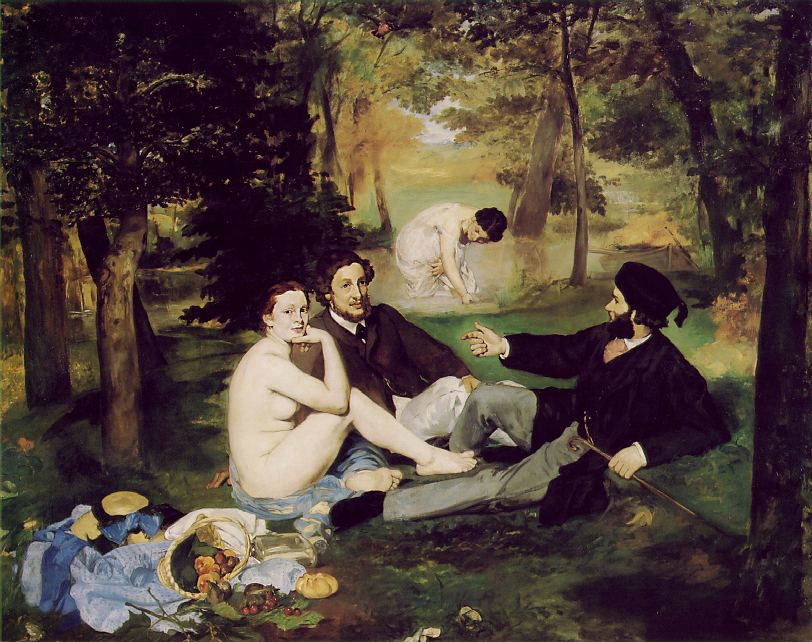Art Talk: Le Déjeuner Sur l'Herbe - an analysis
During the second half of the IXX century, the French artists' primary mode of exhibiting was through the Paris Salon (an institution created by the Royal Academy of Painting and Sculpture in 1667, and highly 'supported by Louis XIV' (Delacour and Leca 2011).
During the Empire of Napoleon III, the Salon gained even more appeal in the eyes of artists who wished to make a name for themselves. The number of artists in the Parisian area grew drastically, as much as their desire to be exhibited.
Therefore, in 1843, the Salon experienced a 'demographic pressure', and from the 4,000 works that were 'submitted', only 1,637 were exposed (Delacour and Leca 2011).
Moreover, artwork was judged by a 'jury', and the selection criteria was extremely conservative and classicist: to be accepted in the Salon, artworks had to represent themes of a 'historical, mythological, or Biblical' nature (Delacour and Leca 2011).
It was only after the pressures coming from the new generation of artists (such as Realists and Impressionists), that Napoleon II 'decreed that [the] public should be allowed to judge works by itself' (Delacour and Leca 2011).
The Salon des Refusés was born: artists such as Manet and Monet that had been rejected by the jury, now had the possibility of exhibiting their work to the public. Certainly, being a 'refusé' could have presented negative repercussions on the artists' career, however, as Goustave Courbet pointed out in 1847:
Having gained an insight on the traditional and conservative atmosphere of the Salon, it will now become clearer how Manet's painting in question, Le Déjeuner sur L'Herbe (1863) was considered highly controversial.
The scene depicts three young people having a picnic in the countryside. The colours of the trees and surrounding nature in the background are dark, therefore, the light concentrates itself on the three characters.
The men's dark clothes put the woman's naked body even more at the centre of attention.

Le Déjeuner sur l'Herbe provoked much scandal, especially since it depicted a nude woman. Nudity was well accepted in the Salon only if it was within the parameters of fine art and classicism.
Contrarily to tradition, Manet's woman not only did not possess the perfect body attributed to a Venusian beauty, but also, did not have a historical or mythological background (Ledeunffgwen 2015).
In fact, the scene takes on a more erotic character: the two men are dressed and are casually discussing between each other without showing any concern or shock for the naked women in front of them (Ledeunffgwen 2015). They appear to be used to her presence. Moreover, her look is completely engaged with the spectator, making the experience feel realistic (after all the size of this painting is H.208cm, L. 264.5cm).
Some believe that the two women in the painting have consummated their love with the present men: and now, one is still sitting naked with nonchalance, whereas the other is bathing after intercourse (Ledeunffgwen 2015).
It is interesting to observe how Le Déjeneur sur l'Herbe was initially a highly controversial painting in the Parisian artistic milieu. Today, it is one of the most precious and celebrated paintings in the history of art since it marked the beginning of modernity.
BIBLIOGRAPHY
Delacour, H. and Leca, B. (2011). The Decline and Fall of the Paris Salon: a study of the deinstitutionalisation process of a field configuring event in cultural activities. Management. Vol. 14. Available from: https://www.cairn.info/revue-management-2011-1-page-436.htm
Ledeunffgwen (2015). Généalogie d'une photographie: 'Le Déjeuner sur l'Herbe' de Manet. [online] Available from: https://ledeunffgwen.wordpress.com/2015/02/15/genealogie-dune-photographie-le-dejeuner-sur-lherbe-de-manet/
Manet, E. (1863). Le Déjeuner sur l'Herbe. [Image] Available from: https://www.cairn.info/revue-management-2011-1-page-436.htm
Sneaky Ninja Attack! You have just been defended with a 2.71% upvote!
I was summoned by @francescap1995. I have done their bidding and now I will vanish...
woosh
A portion of the proceeds from your bid was used in support of youarehope and tarc.
Abuse Policy
Rules
How to use Sneaky Ninja
How it works
Victim of grumpycat?